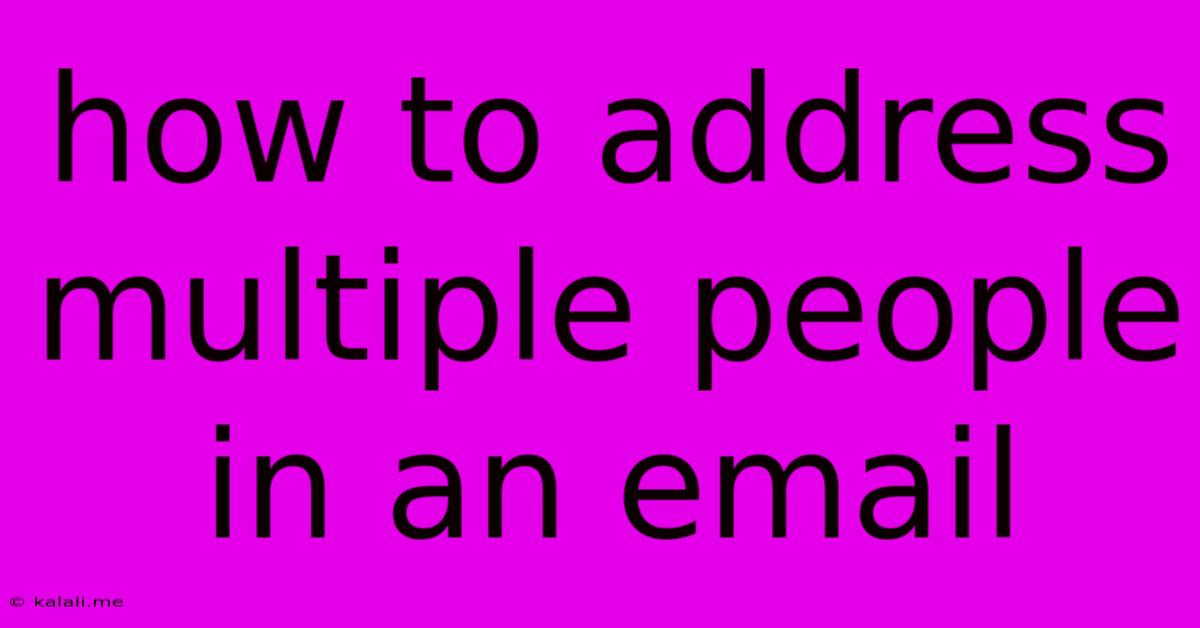How To Address Multiple People In An Email
Kalali
May 22, 2025 · 3 min read

Table of Contents
How to Address Multiple People in an Email: A Guide to Professional Etiquette and Effective Communication
Addressing multiple people in an email can be tricky. One wrong move and you risk appearing unprofessional, confusing, or even rude. This comprehensive guide will walk you through various scenarios and best practices to ensure your email is both effective and polite, regardless of your audience. This includes understanding the nuances of using "To," "Cc," and "Bcc" fields, as well as crafting the perfect salutation for different group dynamics.
Understanding Email Etiquette: To, Cc, and Bcc
Before diving into salutations, let's clarify the purpose of the different email fields:
-
To: This field is for the primary recipients – the people who need to act on or respond to your email. Only include individuals directly involved in the email's purpose here.
-
Cc: (Carbon Copy) Use the Cc field to keep others informed. Recipients in the Cc field receive the email but aren't expected to reply. This is useful for keeping stakeholders updated or for creating a record of communication.
-
Bcc: (Blind Carbon Copy) Use the Bcc field for privacy. Recipients listed here won't be visible to other recipients. This is ideal for sending an email to a large group where you don't want to expose everyone's email addresses. It’s also useful for sending a sensitive email to multiple people while preserving the privacy of their email addresses.
Choosing the Right Salutation:
The salutation is the first impression your email makes. Here's how to handle different situations:
1. Addressing a small group (2-3 people) you know well:
- Option 1 (Informal): Use their first names: "Hi John and Jane," or "Hey team," if appropriate.
- Option 2 (Semi-formal): Use a combination: "Hi John, Jane, and Sarah,"
2. Addressing a larger group or people you don't know well:
- Option 1 (Formal): Use a general greeting: "Dear Team," "Dear Hiring Committee," or "Dear Project Stakeholders."
- Option 2 (Semi-formal): List everyone's name, but this is less ideal for larger groups. "Dear John, Jane, Sarah, and Mark,"
3. Addressing a mixed group (formal and informal relationships):
- Option 1 (Best Practice): Err on the side of formality. Use a general salutation like "Dear Team" or "Dear Colleagues."
- Option 2 (Alternative): If you know the group well and have a casual work environment, consider a more casual approach but still maintain professionalism. This is situational and requires good judgment.
4. Addressing emails to specific roles or titles:
- Formal: Use titles and last names: "Dear Mr. Smith and Ms. Jones," or "Dear Dr. Lee and Professor Brown."
Writing the Email Body:
Once you've chosen your salutation, remember to maintain consistency throughout the email. If you use formal language in the salutation, maintain that tone in the body of the email. Avoid using overly casual language, slang, or abbreviations, unless it aligns with your established communication style within the group.
Example Scenarios:
- Scenario 1: Project Update: "To: Project Team, Cc: Project Manager" - Salutation: "Hi Team,"
- Scenario 2: Job Application Follow-up: "To: Hiring Manager, Bcc: Recruiter" - Salutation: "Dear [Hiring Manager's Name],"
- Scenario 3: Company-wide Announcement: "To: All Staff, Bcc: IT Department" - Salutation: "Dear Colleagues,"
Key Takeaways:
- Consider your audience: The level of formality should match the context and your relationship with the recipients.
- Use the correct fields: Utilize "To," "Cc," and "Bcc" appropriately for clarity and privacy.
- Maintain consistency: Keep the tone of your salutation and email body consistent.
- Proofread carefully: Double-check for any errors before sending.
By following these guidelines, you can effectively and professionally address multiple people in your emails, ensuring clear communication and a positive impression. Remember, mastering email etiquette is crucial for building strong professional relationships and enhancing workplace communication.
Latest Posts
Latest Posts
-
How To Delete Linkedin Account Without Password
May 22, 2025
-
How To Divide A Small Number By A Big Number
May 22, 2025
-
Reheating A Meat Pie In The Oven
May 22, 2025
-
Is There More Land Or Water On The Earth
May 22, 2025
-
Can You Heat Plates In The Microwave
May 22, 2025
Related Post
Thank you for visiting our website which covers about How To Address Multiple People In An Email . We hope the information provided has been useful to you. Feel free to contact us if you have any questions or need further assistance. See you next time and don't miss to bookmark.